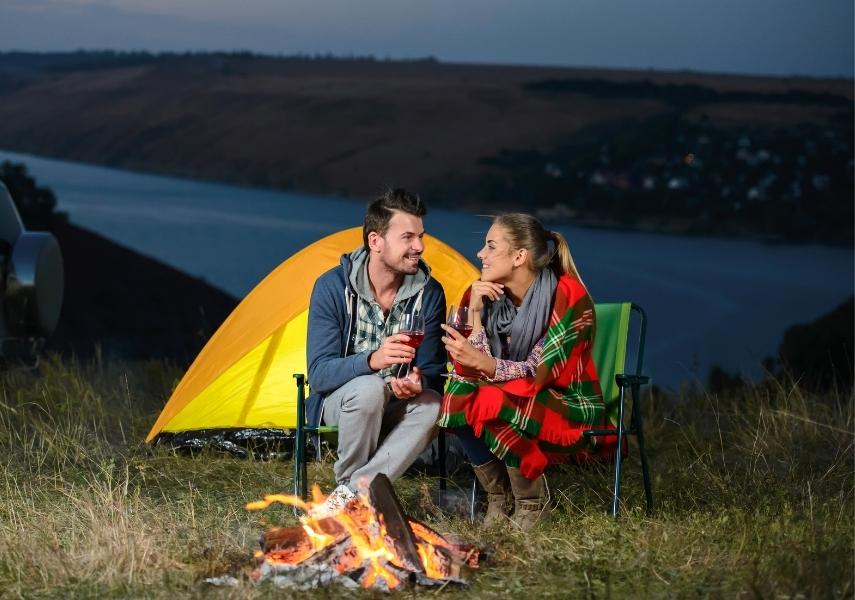15 Camping Tips You Cannot Do Without!

1. Homemade tick repellent
We have loads of ticks and mozzies in South Africa so be sure to either pack your insect repellant or make your own. I found this recipe for a homemade version online and it seems to have worked on my pets.
- Mix together 2 cups of distilled white vinegar with 1 cup of water
- Pour this solution into a spray bottle and spray onto clothing, skin, and hair before heading out into the bush. o
- Reapply this solution every 4 hours to keep the insects at bay.
- Add a few drops of an essential oil to get rid of the vinegary smell.
2. Take extra ground sheets
There is absolutely NOTHING worse when camping than having muddy floors. You’ll want to relax but can’t so take extra ground sheets with you. These can also double-up as wind breakers and privacy screens if you tie them up between your tents, caravans, and cars.
3. Pick a campsite wisely
You may think that setting up camp near the ablutions would be a great idea but these are high traffic areas which means noisy and possibly even stinky. Think again and enjoy the walk to your loo.
4. Create zones in your camp
Just like you would at home, create zones for the different activities i.e. a sleeping/relaxing zone, a kitchen zone, a laundry zone etc. Space is at a premium so make full use of it. Hang things up where you can and keep clothing tidy.
5. Bathroom must haves
Public bathrooms have all sorts of germs that aren’t your friend so make sure you have flip flops for your feet and anti-bacterial spray for the toilet seat. I would also recommend having a waterproof bag/basket available that you can put all your toiletries into when using the shower cubicle. Wet wipes are also a must and DON’T FORGET the toilet paper.
6. Always pack duct tape
Duct tape is great for patching holes in tents, shoes, inflatable mattresses, mosquito nets and loads more.
7. Bring your own water
Although you will have access to water at your campsite, it may be naturally sourced water that you need to purify. If you want to be on the safe side, pack some large water containers. Doing this will also save you time because you won’t need to constantly boil and cool water when you need.
8. Bring earplugs
Enjoy your sleep? I know I do but I’m a light sleeper so I would strongly recommend that you take earplugs with you. Noise travels in the big outdoors so if you’ve got a snoring neighbour or party animals next door, you’ll be very glad you can block them out.
9. Entertainment
Pack a bag with board games, cards, books, note pads, and pens to keep you and the little ones busy.
10. Do not leave food unattended
Not only do you not want to loose food when you don’t have easy access to a shop but you don’t want to encourage the wildlife to eat your food. Keep food in sealed airtight containers and preferably locked away out of reach.
11. Keep a first aid kit
Ensure you have a First Aid kit at your campsite at all times. Fill this box with plasters, antiseptic creams, anti-nausea tablets, anti-diarrhoea medicine, water purification tablets, cotton swabs, hand sanitiser, pain pills, antihistamines, tweezers, eye drops, and your personal medication prescribed by your doctor. On arrival at the campsite you may also want to enquire about the nearest doctor just in case.
12. Bring your own lighting
Campsites generally have electricity but it never seems enough. Rather bring solar-powered lanterns or oil lamps with you. Keep batteries available for torches and don’t forget to pack extension cords and plugs. If you are setting up extra lighting, make sure that no electric cables are exposed to the elements.
13. Bring the right tools
Create a dedicated tool box for camping that contains everything you need at a campsite including a pump (or else you’re really going to give your lungs a workout)!
14. Pack disposable products
To cut down on washing up, use paper plates, cups and disposable utensils. You can then clean up quickly and easily.
